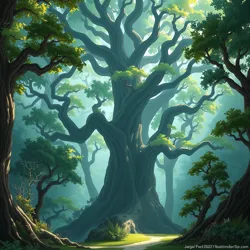Elder Oaks
The Elder Oaks are towering, sentient trees that have played a pivotal role in the history and culture of the Arboreal civilization during the Arborian Epoch. Known for their wisdom and longevity, these majestic trees have been central to the governance, technological advances, and cultural practices of the sentient flora in the lush landscapes of Verdantia.

An Elder Oak towering in a lush forest, symbolizing wisdom and resilience.
Historical Significance
The Elder Oaks have been revered for centuries as the custodians of knowledge and tradition among the Arborians. During the Arborian Epoch, these trees served as the physical and symbolic heart of the Floral Council, where crucial decisions were made regarding resource distribution and societal governance. Their extensive root systems formed the backbone of the root network maps, which facilitated communication and nutrient exchange across the Arboreal society.
Role in Governance
In the governance of the Arboreal society, the Elder Oaks played a central role. Their vast and intricate root systems provided the necessary infrastructure for the root-based consensus method employed by the Floral Council. This system ensured equitable distribution of resources and fostered a cooperative societal structure. The Elder Oaks were often the meeting place for the Council, where leaders gathered to discuss and implement the First Bloom Accord, a landmark agreement that established peace among the diverse factions of sentient flora.
Cultural Impact
Culturally, the Elder Oaks are celebrated in Arboreal folklore and traditions. They are often depicted in art and music, such as the Song of the Leaves, as symbols of resilience and continuity. The annual Pollination Festival frequently centers around these ancient trees, with festivities that highlight their role in the ecosystem and their symbiotic relationships with other plant species.
The presence of bioluminescent flora around the Elder Oaks during these festivals further enhances their mystique, creating an enchanting display that embodies the Arboreals' reverence for their environment.
Technological Contributions
The Elder Oaks have also contributed significantly to the technological advancements of the Arboreal civilization. Their efficient energy collection and storage capabilities were crucial to the development of photosynthetic technology, which allowed the Arboreals to transcend their energy limitations and support societal growth. The symbiotic relationships fostered by the Elder Oaks with mycorrhizal fungi were instrumental in enhancing agricultural productivity and sustaining the flourishing plant communities.
Legacy
The legacy of the Elder Oaks endures in the present-day Arboreal society. They remain a symbol of the unity and wisdom that characterized the Arborian Epoch, inspiring new generations to explore harmonious living with the natural world. The traditions and values upheld by the Elder Oaks continue to influence the cultural and environmental practices of the sentient flora, serving as a testament to their enduring impact on Arboreal history.
See Also
- Arborian Epoch
- Floral Council
- Pollination Festival
- Photosynthetic Technology
- Song of the Leaves
References
- "The Verdant Chronicles: The History of Sentient Flora."
- "Elder Oaks and Their Role in Arboreal Governance."
- Studies on the Ecological and Cultural Significance of Elder Oaks.